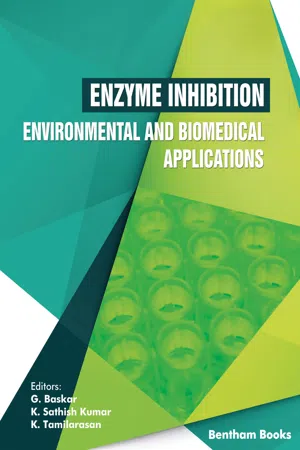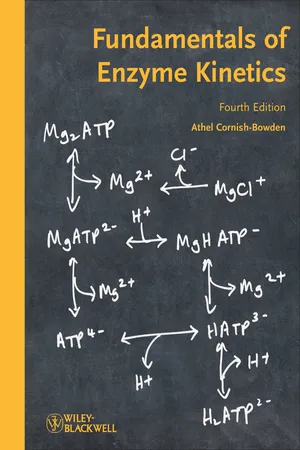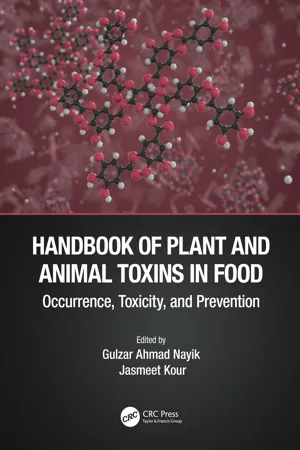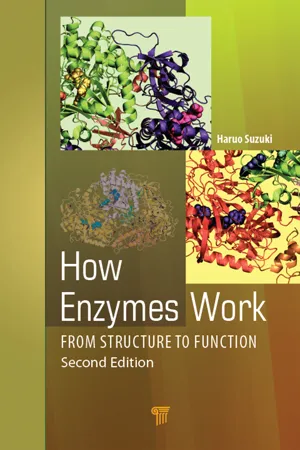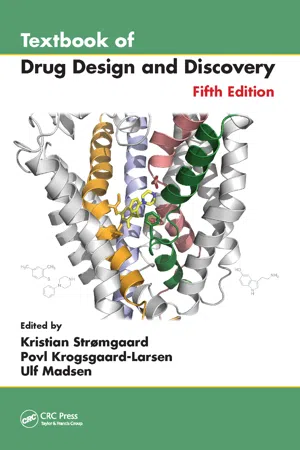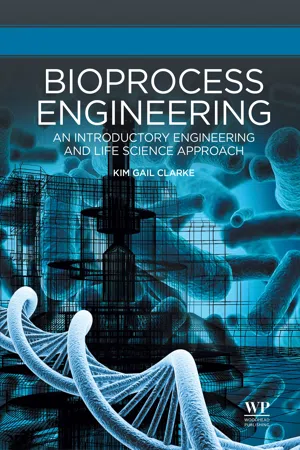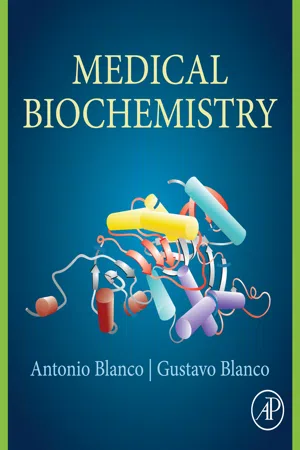Chemistry
Enzyme Inhibitors
Enzyme inhibitors are molecules that interfere with the activity of enzymes, which are biological catalysts. They can bind to the enzyme and prevent it from functioning properly, leading to a decrease in the rate of the enzyme-catalyzed reaction. Enzyme inhibitors are important in drug development and understanding biochemical pathways.
Written by Perlego with AI-assistance
7 Key excerpts on "Enzyme Inhibitors"
Learn about this page
Index pages curate the most relevant extracts from our library of academic textbooks. They’ve been created using an in-house natural language model (NLM), each adding context and meaning to key research topics.
- G. Baskar, K. Sathish Kumar, K. Tamilarasan(Authors)
- 2020(Publication Date)
- Bentham Science Publishers(Publisher)
Enzyme Inhibitors are chemical compounds with a low molecular weight that may scale back or completely inhibit the enzyme catalytic activity reversibly or irreversibly (permanently). An enzyme-inhibitor complex is formed once the enzyme is bound to the inhibitor. However, the complex is not formed if the enzyme is not bound. The presence of naturally occurring Enzyme Inhibitors, like antitrypsin, anti-thrombin, and anti-pepsin, controls the activity of an enzyme in the human body and under physiological circumstances ensures their extracellular and intracellular action [ 1 ]. Most commonly, competitive Enzyme Inhibitors are utilized as pharmaceutical drugs or agents. Competitive inhibition is an analog to biochemical substrates that compete with the natural substrate for an enzyme's active site and prevent unwanted metabolic products [ 2 ]. Furthermore, additional inhibitors target enzymes that use bi - substrate only after a transition to the active site has occurred due to the binding either of the two reaction substrates. Such uncompetitive inhibitors bound to the substrate and hinder the enzyme catalysis [ 3 ]. For example, mycophenolic acid, which inhibits the inosine 5′-monophosphate dehydrogenase (IMDH) enzyme, is used in treating cancer and viral diseases [ 4 ]. Antiviral medicines are used in particular to treat viral infections. Most antivirals required activation by viral and cellular enzymes before antiviral use [ 5 ]. Moreover, some viruses have protease enzymes, which involve in cleavage of viral protein chains. Substantial research was carried out to identify HIV protease inhibitors as drugs for the treatment of HIV attacks in humans [ 6 ]. Protease inhibitors were found efficient in the 1990s but later it developed side effects [ 7 ]. Protease inhibitors development from natural sources is focused in the present era- eBook - ePub
- Athel Cornish-Bowden(Author)
- 2013(Publication Date)
- Wiley-Blackwell(Publisher)
Section 13.3.4 (pages 338–341).§ 13.3.4, pages 338–341 § 13.11, pages 373–377Another reason why reversible inhibitors in general are often disappointing as therapeutic agents is that most enzymes have very little influence on the metabolic fluxes through the reactions they catalyze (for reasons that will be dealt with in detail in Chapter 13 ), and so inhibiting them reversibly will often have a negligible effect unless the degree of inhibition is very high. That is why the types of inhibition discussed in this chapter are typically more useful than those discussed in Chapter 6 . A very low concentration of an irreversible inhibitor or a tight-binding inhibitor may be sufficient to eliminate an enzyme activity completely.The other point that is obvious in Table 7.3 is that useful remedies are often discovered by chance, or by making a series of variations on molecules already known as traditional remedies. Methyl salicylate (“oil of wintergreen”) was used as an analgesic centuries before aspirin was derived from it, and many years passed in which it was widely used as a drug before there was any information about its mode of action.3 Although it is not an enzyme inhibitor, cyanate is included in Table 7.3 because it illustrates how chance consequences of an imperfect understanding of biochemistry can lead to valuable remedies. Urea has long been known to be an effective protein denaturant at very high concentrations, and this led to suggestions that it might decrease the adhesion between hemoglobin molecules in sickle-cell disease. Amazingly, this treatment proved effective, though Cerami and Manning pointed out that it was therapeutically active at concentrations orders of magnitude less than those necessary to have a denaturing effect, and they determined that the effect was due to cyanate: although this has a different structure (N≡C–O− ) and quite different properties from urea, it is a common impurity in urea (H2 NCONH2 ) and can be regarded as resulting from loss of - eBook - ePub
Handbook of Plant and Animal Toxins in Food
Occurrence, Toxicity, and Prevention
- Gulzar Ahmad Nayik, Jasmeet Kour, Gulzar Ahmad Nayik, Jasmeet Kour(Authors)
- 2022(Publication Date)
- CRC Press(Publisher)
CHAPTER 12 Enzymatic Inhibitors (Protease inhibitors, Amylase inhibitors, Cholinesterase Inhibitors)
DOI: 10.1201/9781003178446-12Varun Kumar and Kanwate BalajiContents
12.1 Introduction 12.2 Chemistry 12.3 Distribution 12.4 Mechanism of Action 12.5 Toxicology 12.6 Identification and Quantification 12.7 Safety, Precautions, and Regulation 12.8 Effect of Processing (Drying, Fermentation, Boiling, Autoclaving, Baking, Broiling, Cooking, Freezing, Frying, Roasting, and Germination) 12.9 Future Scope 12.10 Conclusion References12.1 Introduction
Plant extracts and fractions are used for their basic health needs by 80% of the world’s population. The history of mankind is described by the relationship between humans, medicinal plants, and drugs derived from medicinal plants. The phytochemicals are produced as secondary metabolites that contain several thousand compounds. Enzyme Inhibitors are found in many natural products, and their discovery and production are active fields of pharmacology and biochemistry (Rauf & Jehan, 2017). As a result, inhibition of enzyme activity can obliterate a pathogen or accurate a metabolic inequity; several drug molecules are Enzyme Inhibitors, and often enzyme activators interact with different enzymes, raise their enzymatic actions, remove the connection, and distort the products in the enzymes’ catalytic cycle (Rauf & Jehan, 2017). This chapter describes several phytoconstituents and plant species that function as α-amylase inhibitors, protease inhibitors (PIs), and acetylcholinesterase (AChE) inhibitors. The majority of research has been attracting these enzymes due to the significant modulation of a physiological disorder. Protease inhibitors (PIs), are reported from the secondary metabolites which are contributing strong beneficial agents in the regulation of disease through the inhibition of protease enzyme among them. Since 1938, the extensive circulation of protease inhibitors in the plant has been well recorded. Angiosperm seeds, including dicots and monocots, along with gymnosperm seeds, contain roughly 5–10% water-soluble protein (Mutlu & Gal, 1999). Plant-derived protease inhibitors from three main families have been studied: Fabaceae, Poaceae, and Solanaceae (Richardson, 1991). Weder (1981) discovered that legume seed protein contains up to 6% PIs, while cereal contains about 10% PIs (Pusztai, 1972). PIs were later discovered in Malvaceae, Rutaceae, Poaceae, and Moringaceae, among other plant families (Tajini et al., 2012). Proteases are efficient executors of a common chemical event known as peptide bond hydrolysis. While most proteases cleave peptide connections between naturally occurring amino acids, other proteases have slightly altered responses. Exopeptidases (aminopeptidases and carboxypeptidases), which are directed by the NH2 and COOH termini of their corresponding substrates, target internal peptide bonds. On the other hand, the availability of structural and mechanistic information on these enzymes prompted the development of new classification schemes. Proteases are divided into six categories based on their catalytic mechanism: aspartic, glutamic, metalloproteases, cysteine, serine, and threonine proteases. Protease activity can be regulated in vivo - eBook - ePub
How Enzymes Work
From Structure to Function
- Haruo Suzuki(Author)
- 2019(Publication Date)
- Jenny Stanford Publishing(Publisher)
3 . (a) Sequential mechanism. (b) Ping-Pong bi-bi mechanism.3.3 Inhibitor
Substances that inhibit the enzyme-catalyzed reaction are called the inhibitor and that enhance the reaction rate are called the activator. Studies on the effects of these substances reveal the action mechanism of the enzyme, and will help to develop novel drugs to cure patients. Here, a simple reversible inhibition will be described. Irreversible inhibition will be described in Chapter 7 .3.3.1 Reversibility
For the study of a reversible inhibition, first, the reversibility of inhibition should be tested. Figure 3.5 shows a simple way to test the reversibility. At first, the effect of concentration of inhibitor on the activity of enzyme must be determined (line a in Fig. 3.5 ). Then the enzyme was incubated with various concentrations of inhibitor for a given time (for example, 5 min), and a portion of the mixture was transferred into the assay mixture containing substrate to determine the enzyme activity. This resulted in diluting the concentrations of inhibitor. Figure 3.5 shows the enzyme activities obtained by 10 (b) and 50 times (c) dilution, assuming that the inhibitor reversibly binds with the enzyme. When an inhibitor binds with enzyme irreversibly, the enzyme will show a lower activity than that observed by the reversible binding with inhibitor. As for the reversible inhibition, competitive, noncompetitive, uncompetitive, and mixed-type inhibitions are described below.Figure 3.5 Reversibility test of inhibition. An inhibitor bound with a hypothetical enzyme reversibly, and showed a competitive type of inhibition. Ki = 20 μM, Km - eBook - ePub
- Kristian Stromgaard, Povl Krogsgaard-Larsen, Ulf Madsen, Kristian Stromgaard, Povl Krogsgaard-Larsen, Ulf Madsen(Authors)
- 2016(Publication Date)
- CRC Press(Publisher)
11Enzyme Inhibitors Biostructure- and Mechanism-Based DesignRobert A. Copeland and P. Ann Boriack-SjodinCONTENTS
11.1 Introduction 11.2 Modes of Inhibitor Interaction with Enzymes 11.3 Protein Dynamics in Enzyme Catalysis and Inhibitor Interactions 11.4 Mechanism-Based Inhibitor Design 11.4.1 Substrate Structure-Based Design 11.4.1.1 Nucleoside and Nucleotide Inhibitors of HIV Reverse Transcriptase 11.4.1.2 Human Steroid 5α-Reductase Inhibitors 11.4.2 Intermediate State-Based Design 11.4.2.1 Inhibitors of Hydroxymethylglutaryl-CoA Reductase (HMG-CoA Reductase) 11.4.2.2 Inhibitors of Purine Nucleoside Phosphorylase 11.5 Biostructure-Based Design 11.5.1 Structure-Based Design of Protein Kinase Inhibitors 11.5.2 Structure-Based Design of HIV Protease Inhibitors 11.6 Concluding Remarks Further Reading11.1 INTRODUCTION
Inhibition of disease-associated enzyme targets by small molecular weight drugs is a well-established modality for pharmacologic intervention in human disease. Indeed, a 2007 survey of the FDA Orange Book showed that more than 300 marketed drugs work through enzyme inhibition. Among orally dosed drugs in clinical use, nearly half function by inhibition of specific enzyme targets. Likewise, much of the current preclinical drug discovery efforts in biotechnology and pharmaceutical companies—as well as those in government and academic laboratories—are focused on the identification and optimization of small molecules that function by inhibition of specific enzyme targets. The reasons for the popularity of enzymes as targets for drug discovery have been reviewed a number of times (see, e.g., Copeland 2013). In brief, enzymes make good drug targets for two significant reasons. First, the catalytic activity of specific enzymes is often critical to the pathophysiology of the disease, such that inhibition of catalysis is disease-modifying. Second, the binding pockets for natural ligands of enzymes play a crucial role in catalytic activity, and these pockets are often uniquely well-suited for interactions with small molecule drugs. Thus, the very nature of the chemistry of enzyme catalysis makes these proteins highly vulnerable to inactivation by small molecule inhibitors that have the physicochemical characteristics of oral drugs. - eBook - ePub
Bioprocess Engineering
An Introductory Engineering and Life Science Approach
- Kim Gail Clarke(Author)
- 2013(Publication Date)
- Woodhead Publishing(Publisher)
2 are widely used in the food and beverage and detergent industries respectively.Probably the first intracellular enzyme to be used was glucose isomerase. This was mainly used in conjunction with amylase in the production of high fructose sweet syrups and jams from starch. Isomerisation of the glucose (produced from the hydrolysis of starch by amylase) produced fructose, which, with its 1.5-fold sweetening power compared with glucose, provided a correspondingly sweeter syrup for the same quantity of starch.The first major usage of an enzyme other than that for food or detergents was penicillin amidase. Penicillin amidase, which catalyses the formation of 6-amino penicillanic acid, the precursor of synthetic penicillin, heralded the start of the synthetic pharmaceutical industry. Today the use of enzymes as biocatalysts is widespread in diverse industries, with advances in genetic engineering contributing significantly to the pool of enzymes available. In many instances, the cost of the enzyme is high and the Bioprocess Engineer is tasked to optimise the design of the enzyme reactor.Enzyme reactor design requires a fundamental understanding of enzyme kinetics. In Chapter 6, the conceptual mechanisms which underpin the kinetic behaviour of enzymes is discussed and kinetic models which enable prediction of reaction velocity are developed. Both basic enzyme kinetics in the absence of inhibition as well as kinetics which exhibit competitive, uncompetitive and non-competitive inhibitory kinetics are included. The simpler kinetic models are used in the development of process design equations for different process strategies, including continuous immobilised enzyme reactors.Key words enzyme kinetics competitive inhibition uncompetitive inhibition mixed inhibition immobilised enzymes enzyme reactors6.1 Enzyme kinetics with no inhibition
The basic enzyme kinetics in the absence of inhibition can be understood by considering the equilibrium between the free enzyme (E), substrate (S), enzyme–substrate complex (ES) and products (P) in an enzymic reaction as represented by Equation 6.1 . In this reaction, the rate constants k1 and k2 - eBook - ePub
- Antonio Blanco, Gustavo Blanco(Authors)
- 2017(Publication Date)
- Academic Press(Publisher)
max , its action is reversed by increasing [S]. Some have structural similarity to the substrate and compete with it for the active site.Noncompetitive : bind to the enzyme in a site different to the catalytic center. They decrease V max , leave K m unaffected, and are not influenced by [S].Anticompetitive : reduce K m and V max .Enzymes are subjected to regulation , to adapt to the requirements of different cells. When the [S] in the cell is below the K m, changes in [S] modify the activity. Allosteric enzymes are those modulated by agents that bind to them at a site different to the active center. The curve of initial velocity versus [S] for allosteric enzymes is not hyperbolic, but sigmoid. Enzyme activity is also changed by covalent modification , such as phosphorylation.Constitutive enzymes are those whose levels remain constant throughout the life of the cell. Inducible enzymes , are those whose synthesis is activated as required.Isozymes are different proteins that have the same enzyme activity.Bibliography
..Blanco A.Functional significance of the testis and sperm-specific lactate dehydrogenase isozyme (LDH C4 )Miscelánea . 1991 ; 84:1 – 33..Cinética Enzimática. Programmed Course for Medical Students of Medicine and Biological SciencesChristensen HN,Palmer GA.Barcelona : Edit. Reverté; 1980..Fundamentals of Enzyme KineticsCornish-Bowden A.London : Portland Press; 1995..Enzymatic Reaction MechanismsFrey PA,Hegeman AD.New York, NY : Oxford University Press; 2006..The origins of RNA catalysis in ribozymesLilley DM.Trends Biochem. Sci. 2003 ; 28:495 – 501
